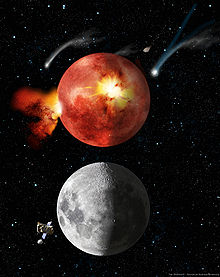Big bombardment
According to the hypothesis of the Great Bombardment ( English Late Heavy Bombardment, LHB ), when the solar system was around 600 million years old, there was a relatively short phase with frequent impacts, sometimes very large asteroids . While the tracks on earth have long been erased by plate tectonics , the dating of lunar rocks surprisingly revealed a uniform age of 3.95 billion years. The LHB may have delayed the creation of life on earth significantly. More recently, the LHB hypothesis has been increasingly questioned.
History of the hypothesis
The Great Bombardment followed from the results of the potassium-argon dating of lunar rocks, which had been brought to earth by the Apollo astronauts in 1969–1972 and by probes of the Soviet Luna program in 1970–1976 . It was found that the cooling age of most of the (around 50) examined samples fell within a geologically relatively short range, around 500 million years after the formation of the earth-moon system . Mineralogical features of these samples suggested that they came from multiple collisions.
Meteorites originating from the moon were later dated. The age of the LHB was not found to be higher than 3.95 billion years, but there was a broad, decreasing frequency distribution of younger material.
The Nice model was cited as the cause of the accumulation , according to which the gas planets Jupiter to Neptune were formed at a smaller distance from the sun and then migrated into their current orbits . In the process, smaller bodies, as they can still be found in the Kuiper Belt today, were disturbed and some of them thrown into the inner solar system. However, more precise calculations showed that the migration was faster and that a delayed migration is very unlikely.
Doubts have also arisen about the origin of the material used for the lunar samples. It is considered possible that especially the samples taken by Apollo 17 in Mare Serenitatis are actually ejecta from the impact that formed the Mare Imbrium , the temporal proximity of rocks from Mare Serenitatis and Mare Imbrium would therefore only be apparent and the impact through that the Mare Serenitatis was created is much longer ago. This calls into question the theory of the Great Bombardment as a whole. Other scientists point to the huge South Pole Aitken Basin and the generating impact as the cause of simultaneous melting.
Effect on the moon and earth
On the Earth's moon, the larger bodies led to the formation of the lunar seas , as magma penetrated upwards from their impact points and formed extensive, flat basalt and lava layers . Local mass surpluses in the interior of our satellite, the so-called mascons , which are probably caused by the heavy nuclei or remnants of the impacted asteroids, can still be detected today at anomalies in the gravitational field of the moon .
The medium-sized bodies of the bombardment (1 to 20 km) formed most of the lunar craters and ring mountains that are still visible today , which are up to 300 km in diameter. As a guideline, it can be assumed that the resulting impact crater is 10 to 20 times larger than the impact body itself. This is the result of the explosive, sudden evaporation of the impacting material.
After the Great Bombardment, the impacts became less frequent because the eight planets had "cleared" the area around their orbits of smaller bodies. This is why the later lunar craters have much smaller diameters.
The conditions on the planets Mercury and Mars were similar and their traces can also be seen to this day. Significantly fewer traces of the craters of the bombing have been preserved on earth due to the overturning of the earth's crust by plate tectonics and erosion ( rock cycle ), and on the ocean floors only those that are younger than about 300 million years, i.e. long after emerged from the bombardment.
See also
literature
- P. Moore, G. Hunt: Atlas of the Solar System Herder, Freiburg-Basel-Vienna 1990
Web links
- Wissenschaft.de: The traces of the last major attack from space , December 15, 2007
- New Insight into Earth's Early Bombardment , space.com April 17, 2006
- Spektrum .de: Did the solar system come to rest earlier than expected? 16th August 2019
Individual evidence
- ^ Adam Mann: Bashing holes in the tale of Earth's troubled youth. Nature 553, 2018, doi: 10.1038 / d41586-018-01074-6 .
- ↑ Paul D. Spudis, Don E. Wilhelms, Mark S. Robinson: The Sculptured Hills of the Taurus Highlands: Implications for the relative age of Serenitatis, basin Chronologies and the cratering history of the Moon. Journal of Geophysical Research 116, 2011, doi: 10.1029 / 2011JE003903 .
